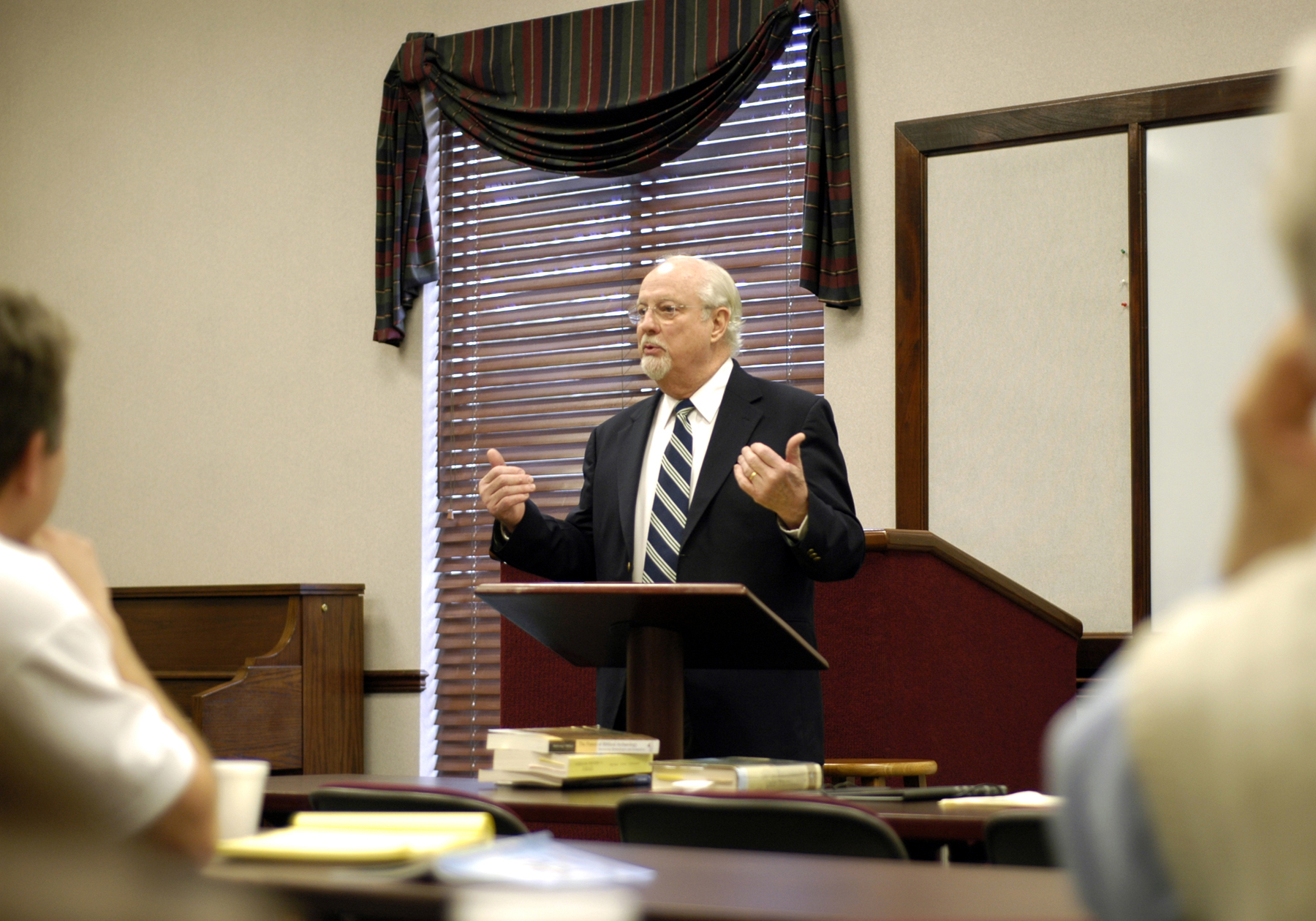
NEW ORLEANS (BP)–Revisionist scholars in Europe are ignoring a wealth of archaeological evidence in seeking to discount and, ultimately, erase belief in the biblical Israel, noted archaeologist William Dever said at New Orleans Baptist Theological Seminary.
Dever, professor emeritus of Near Eastern archaeology and anthropology at the University of Arizona, shared his research during the Manuel Family Lecture on Archaeology and the Bible in early February. The lecture is designed to present current archaeological research pointing to the reliability of Scripture.
Dever described the revisionists’ propositions as: “There is no history in the Hebrew Bible. It’s all written too late to be reliable. It is all a myth. There was no real ancient or biblical Israel. There was no exodus, no Sinai, no [Hebrew] faith, no conquest of Canaan, no Israelite ethnicity.”
“In fact,” Dever said, “they have recently argued that Hebrew is not a Semitic language.”
Dever said the revisionists discount the early Hebrew state as well as King David and King Solomon and the historical prophets, and they view the stories of the Bible as social constructs of a later period. These scholars even deny the exile and the return.
“In the end, there is, in fact, nothing left,” Dever said of the revisionists’ view. “The Hebrew Bible is the greatest literary hoax ever perpetuated in history until these clever fellows figured it out 10 years ago.”
Though this postmodern movement seeks to sap the Bible of its historical significance and accuracy, Dever maintains that the archaeological evidence supports the biblical accounts of Israel and its kings. His presentation focused on structures he and other archaeologists have uncovered throughout the Holy Land that point to Solomon and the Solomonic Temple. He began with 1 Kings 9:15-16.
The biblical text records that the Egyptian pharaoh had destroyed Gezer and burned its remains. After the destruction at Gezer, the text tells that King Solomon rebuilt Gezer and started building projects at Hazor, Megiddo and Jerusalem.
This widespread fortification, Dever said, points to the centralization or statehood of Israel at this time. However, the revisionists do not even believe the Israel of this time (the 10th century before Christ) qualifies as a state.
“Now the revisionists have said Israel was too small to be a state, and they argue there were only a few thousand people in all of Israel and Judah,” he said. “In fact, archaeologists have documented a population of more than a hundred thousand. Statehood, ladies and gentlemen, is not about size. It’s about centralization and complexity.”
Both centralization and complexity, Dever demonstrated, were present in Israel during that period in history. He first offered photographs of the remains found at Hazor, a city equipped with a quadruple entryway gate, guard towers and a double wall.
“We’re talking about monumental defense works that only a king could have sponsored,” Dever said. “A bunch of Israelite farmers didn’t get together one day and say, ‘Let’s build a city gate.’
“This is not vernacular architecture. This is monumental architecture, which could only have been built with the resources that some sort of king in some sort of capital could have commanded.”
This Phoenician-style construction and fortification is not unique to Hazor. Dever offered photographs that illustrate both Megiddo and Gezer were built in the same way, with a quadruple gate, double wall and towers. Each of the sites can be dated to the reign of Solomon, he said. To counter any accusations of being biblically biased, Dever used pottery shards he found while excavating the gate at Gezer to establish a 12th century B.C. date.
“Our date does not come from a literalistic reading of the Bible,” he said. “I would date this material the same way if the Bible had never been written. We’re basing our date on ceramic typology and on textual evidence where we have it.”
Pottery from this period, Dever explained, was burnished by hand. It was not until the ninth century B.C. that pottery was burnished on a wheel. While wheel-burnished pottery has perfectly concentric circles on the surface, hand-burnished pottery does not. In this way, Dever is able to date the pottery from Gezer and Hazor to the time of Solomon.
In addition to dating these sites with ceramic typology, Dever said archaeologists have been able to date them by their levels of destruction. This is another way scholars can attribute Megiddo to Solomon.
“We indeed have a number of destructions [that occurred at Megiddo] in the late 10th century. This is important because, according to both Kings and Chronicles, five years after Solomon’s death this raid took place,” Dever said.
Egyptian chronologies report that Shishak carried out these raids in the year 925. With these Egyptian records, scholars have the date 930 B.C. for Solomon’s death, Dever said.
“So here we have a claim that the levels … were destroyed by this pharaoh around 925,” he said. “If so, they must have been built during the lifetime and reign of Solomon.”
This avenue of evidence also runs through Gezer. Dever displayed pictures taken at Gezer during the 1984 and 1990 dig seasons that show the wall of Gezer was breached sometime in antiquity. The stones making up the gate of the wall were burned and cracked, and the limestone has been melted by fire.
“Within 20 or 30 years of its construction, it is destroyed,” Dever said.
Once again, the evidence that cements the date of this destruction is the pottery found at that level that dates to the 10th century. Dever also noted that, while archaeologists have used the Carbon 14 dating system to attribute other attacked sites to Shishak, they have no datable samples from Gezer. In the summer of 2006, Steven Ortiz, director of the NOBTS Center for Archaeological Research and former student of Dever, hopes to lead students in a new excavation at Gezer. One of his objectives is to gather Carbon 14 data from Gezer. According to Dever, there is much yet to uncover at Gezer.
“Some of my esteem for Steve is the fact that I have not asked any of my other students to follow up my work at Gezer, but I am proud the work will resume,” Dever said. “We raised the questions. Steve is going to get the answers.”
On the displaced stones at Gezer, Dever and his team also found strange distorted letters etched into their sides — Phoenician mason marks identical to marks found on stones at Megiddo. This did more than connect Gezer with Megiddo, he said; it provided a possible tie to Solomon’s Temple.
First Kings 6:7 says neither hammer nor axe was used in building the temple. Instead, stones were shaped, sorted and marked at the quarry and brought ready-to-assemble to the Temple Mount. These two cities –- Gezer and Megiddo -– must have been built in a similar way.
“At Megiddo, the American excavators even found the chalk lines which the masons snapped to give the line they would use,” Dever said. “I remember the day I called for a plumb bob and a spirit level and checked the original peer of the gate. Three thousand years ago it was established. It is less than a centimeter out of plumb.”
As for Solomon’s Temple, the fourth building project mentioned in 1 Kings 9:15-16, no remains have been found to date. However, the biblical description of the temple coupled with remains of Phoenician temples from the same period give scholars an idea of what Solomon’s Temple looked like.
Still, revisionists ignore such evidence, Dever said.
“They will demolish any facts that don’t suit their theories,” he said.
“If the Hebrew Bible is a literary hoax,” Dever noted, “then you people here are the greatest fools. If it’s not, then we need to think of ways to make it come alive again, and I don’t know any better way than archaeology.”
–30–
















